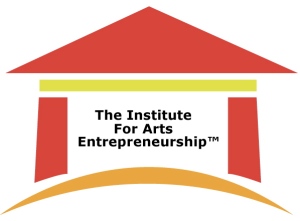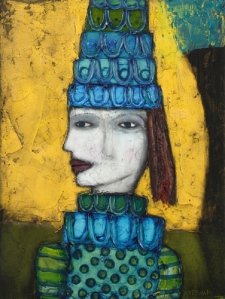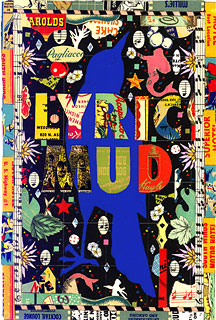Entrepreneurial Arts Training must have equal parts artistic and entrepreneurial techniques. We must invest deeply in each or one will suffer.

The Iceberg Theory w/ Hart's Diagram.
I want to discuss a phenomenon, which is one of the keys to artistic freedom and greatness. Though I give examples from theatre, it is a phenomenon that can be experienced in dance, in painting, writing or any other art form.
- The Japanese call it Mushin.
- Joseph Campbell refers to our brains being a secondary organ.
- The Balinese Topeng dancer transcends present consciousness, becoming a conduit for the Gods.
- Actors refer to this as “going up”.
This all points towards this phenomenon.
This state of mind, what the Japanese call “Mushin”, is where the gems of the creative process occur. What happens in this state is that our conscious mind ceases to attempt to control the creative process and “something else” takes over. We commit to risk. We free-fall, trusting that we will be safe, that there is a net, trusting that the words will come, that our bodies will kick in and that all of the rehearsing we have done, what the French call répétition (repeat) will enable us to let go and release.
We must learn our varied techniques to the degree that they become second nature. We must develop these skills to the point that we do not have to think about the mechanics of our technique. Ex. A master woodcarver does not think about how they are holding the chisel and hammer. They do so naturally, as a result of much practice. It is ingrained within them and no longer needs to be at the conscious level. If one is thinking about their technique, they will not be free and ultimately, their performance or creation will have a stifled quality and not be as dynamic as it can be.
Each of us understands what an impulse is and what it feels like. I like to refer to impulses as being the lighting-quick voice in our heads that says, “Do this. Do this”. In the words of my college theatre professor at SMU, Dale Moffitt, typically, there is a second voice that arises, which he calls, “The watcher at the gates of the mind”. This voice tells us, “Don’t do that. You aren’t doing that right. Everyone is judging you. You aren’t good enough”, etc. It is our job to push this voice down and listen to the constant stream of creative impulses—and here is the trick—to do so without first judging them or being fearful of them.
Often, when creating, we are “mind-full” of external and internal matters, which restricts our ability to create in a fluid, dynamic fashion. To arrive at this state of creating from a place of unconscious thought, we must focus deeply, in an outward fashion and allow ourselves to turn our “minds” off. Using theatre as an example, we cease to be mindful of the audience, of our lines, what action we are sending, the agent or casting director in the audience, etc. Instead, we focus so completely, that all of that fades out of consciousness and we begin to create from “another place”.
Typically, an actor who has “gone up”, only realizes that they have entered this state of consciousness, once they fall out of it. Typically too, one is not entirely aware of the minute choices they made within the moment of this state, as they are no longer observing and controlling, but have released and become a conduit.
It has been my personal experience that when a performer enters this state, the audience cannot help but be sucked in. People, after the show, will often talk about “that moment”, as being amazing. It is during this state, that one expresses “truth”–or so much as can be expressed in the creation of illusion.
The great irony is that if one tries to get to this state of consciousness, they are guaranteed to not get there. Why? Because they are controlling the process. This place is achieved when we free-fall, when we get out of the way of ourselves. We get there by trusting that all of our technique is there, that we are going to be safe, by accepting the inherent risks (which typically translate to mean potential embarrassment). The greatest way to get there is to invest completely in play. We must play as children do.
Surely each of us has engaged in some creation, where we are so engrossed in the process that we lose track of time and find that hours have flown. This is the land of Mushin.
Play is the reason we do what we do, as artists, yes? We can convince ourselves, and others, about all of the higher ideals and purposes we have, being the real reasons we create (social change, to enable others to have catharsis, etc), but the real reason, at its base level, is because it is fun. It gives us bliss. That is why we artists do what we do.
We have fun playing King Lear and tearing at the heavens. We have fun playing Hamlet and experiencing a range of emotion in a few hours that few people experience in a year.
Play, bliss, joy is the way. Controlling, intellectualizing, playing technique, being too mindful is the problem.
Let yourself free-fall. Believe me—there is a net. Once you experience Mushin, if you have not already, you might, as I have, make this state of consciousness, freedom of expression and release the goal and the measure to which you strive in all creative processes.
Jim Hart is the founder of The Hart Technique, TITAN Teaterskole and ACPA (Austin Conservatory of Professional Arts). ACPA will open doors in August of 2010. To reach Hart, email jim@harttechnique.com
www.harttechnique.com
 Join and Cast Ventures: Two Art (Intermedia) students, Jennifer C. and Catherine A., are producing a field guide to the downtown Phoenix arts scene that is itself a work of art.
Join and Cast Ventures: Two Art (Intermedia) students, Jennifer C. and Catherine A., are producing a field guide to the downtown Phoenix arts scene that is itself a work of art. Radio Healer: Led by Arts, Media Engineering (AME) graduate student Christopher M., Radio Healer presents mediated performances that foster intercultural dialogue in Native communities.
Radio Healer: Led by Arts, Media Engineering (AME) graduate student Christopher M., Radio Healer presents mediated performances that foster intercultural dialogue in Native communities. Dance and Health Together Awards: Led by undergraduate Dance major Mary P., the DaHT Awards is a combination of dance recognition award and fundraising enterprise benefiting the Susan G. Komen Foundation.
Dance and Health Together Awards: Led by undergraduate Dance major Mary P., the DaHT Awards is a combination of dance recognition award and fundraising enterprise benefiting the Susan G. Komen Foundation. Co-op Film Productions – Film and Media Production/Marketing student Chelsea R. and her team are creating a support infrastructure for student collaboration across arts and design disciplines.
Co-op Film Productions – Film and Media Production/Marketing student Chelsea R. and her team are creating a support infrastructure for student collaboration across arts and design disciplines. Different from What? Film Festival – AME graduate student Lisa T. in collaboration with Education student Federico W. is producing a film festival focused on films by, for, and about adults with disabilities.
Different from What? Film Festival – AME graduate student Lisa T. in collaboration with Education student Federico W. is producing a film festival focused on films by, for, and about adults with disabilities. Scratch Theory – Filmmaking Practices major Chris G. and his collaborators are developing a software/hardware interface that will first notate and then play back via synthesizer DJ scratching.
Scratch Theory – Filmmaking Practices major Chris G. and his collaborators are developing a software/hardware interface that will first notate and then play back via synthesizer DJ scratching.













